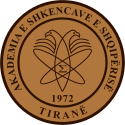Academy of Sciences of Albania
The Academy of Sciences of Albania (Albanian: Akademia e Shkencave e Shqipërisë), founded in 1972, is the most important scientific institution in Albania.[1] In the 1980s, several research institutes began at the University of Tirana were transferred to the Academy's jurisdiction.[2] The institution includes the most distinguished scientists, also called "academics", that are involved in research centers and other organisations inside and outside Albania. As of 2009[update], the Academy had 23 regular members,[3] 10 associated members,[4] one permanent member,[5] and 26 honor members.[6]
 | |
| Abbreviation | ASH / ASA (English) |
|---|---|
| Formation | 10 October 1972 |
| Type | National academy |
| Purpose | Science, Academics |
| Headquarters | Tirana, Albania |
| Coordinates | 41°19′34.7″N 19°49′22.2″E / 41.326306°N 19.822833°E |
| Membership | Academicians (Full members, Associated members, Honorary members, Emeritus members, Correspondent members) |
| Skënder Gjinushi | |
Main organ | Presidency of the Academy |
| Website | akad |
 | |
The Academy was among several dozen of the world's scientific academies which endorsed through signature the Summit Statement emerging from the New Delhi Population Summit of 1994.[7]
Organization
editIn 2023, the Academy of Albanological Studies was integrated into the Academy of Sciences,[8] while the latter was reorganized.
Institutions and Centres
edit- Institute of Archeology
- Institute of History
- Institute of Linguistics and Literature
- Institute of Anthropology
- Centre for Art Studies
- Centre for Encyclopedic and Albanological Publications
Temporary Research Units
edit- Biotechnology and Genetics
- Geophysics
- Water Resources
- Geosciences and Geoengineering
- Artificial Intelligence
- NanoAlb
- Energy
- National Institute of Physics
- National Institute of Mathematics
- Research and Study Unit for the Arbëresh, Arvanites, and Arbënesh
- Scientific Research Center for Biotechnology and Genetics
The Academy of Sciences of Albania has the country's largest academic library. Founded in 1975 starting with 10,000 volumes, it included 812,000 volumes by 1986.[9]
In 2008, funding for most research functions of the academy was withdrawn, those research functions subsequently transferred to universities and research centers.[10] Four research institutes which were separated from the Academy joined to form the Centre of Albanological Studies.[10][11]
Notable current and past members
editRegular members
edit- Skënder Gjinushi[12]
- Albert Doja
- Fatos Kongoli[3][12]
- Beqir Meta[3][12]
- Vasil Tole[3][12]
- Kosta Barjaba
- Aurela Anastasi
- Floresha Dado
- Nazim Gruda
- Anesti Kondili
- Efigjeni Kongjika
- Arben Merkoçi
- Petraq Petro
- Bashim Resuli
- Xhevahir Spahiu
- Jani Vangjeli
- Floran Vila
- Marenglen Verli[4]
- Anila Paparisto
Emeriti members
editAssociate members
editHonorary members
edit- Idriz Ajeti[6]
- Ali Aliu (deceased)[6]
- Francesco Altimari[6]
- Jean Aubouin[6]
- Alain Ducellier[6]
- Bernd Jürgen Fischer[6]
- Victor Friedman[6]
- Eric P. Hamp[6]
- Mark Krasniqi (deceased)[6]
- Mateja Matevski (deceased)[6]
- Andrea Pieroni[6]
- Rexhep Qosja[6]
- Luan Starova[6]
- Răzvan Theodorescu[6]
Notable past members
editFormer notable presidents
editPeriodicals
edit- Studia Albanica, ISSN 0585-5047.
- AJNTS - Albanian Journal of Natural and Technical Sciences, ISSN 2074-0867.
Notes and references
edit- ^ Salzman, Michael, ed. (2003). The World of Learning 2004 (Directory). London: Taylor & Francis (Europa). p. 42. ISBN 9781857431827. OCLC 59288367.
- ^ Misja, Vladimir; Teta, Arqile; Kallulli, Adriatik (1986). Vollmann, W. (ed.). Higher Education in Albania (Report). Monographs on Higher Education. Bucharest: UNESCO-CEPES. p. 33. Retrieved August 21, 2018 – via Internet Archive.
The institutes in question include the Institute of History, the Institute of Linguistics and Literature, the Institute of Folk Culture, the Institute of Nuclear Physics, the Centre for Computer Mathematics, the Seismological Station, and the Hydraulic Research Laboratory.
- ^ a b c d e "Anëtarë të rregullt" [Regular members]. Anëtarë të rregullt (in Albanian). Academy of Sciences of Albania. Archived from the original on March 2, 2012. Retrieved February 20, 2012.[self-published source]
- ^ a b "Anëtarë të Asociuar" [Associated Members] (in Albanian). Academy of Sciences of Albania. Archived from the original on May 31, 2011. Retrieved January 6, 2010.[self-published source]
- ^ a b "Anëtarë të përhershëm" [Permanent Members] (in Albanian). Academy of Sciences of Albania. Archived from the original on May 31, 2011.[self-published source]
- ^ a b c d e f g h i j k l m n o "anetare nderi" [Honorary Members] (in Albanian). Academy of Sciences of Albania. Archived from the original on May 31, 2011.[self-published source]
- ^ Graham-Smith, Sir Francis, ed. (1993). Population — the complex reality: A report of the Population Summit of the world's scientific academies. Boulder, Colorado: North American Press (Fulcrum Publishing). pp. 377–384. ISBN 0-85403-484-6. OCLC 905776096 – via Internet Archive.
- ^ "Riorganizimi i ASA, Akademia e Shkencave: Status i ri si pjesë elitare e kërkimit shkencor" (in Albanian). Lexo.al. Retrieved July 10, 2024.
- ^ Wedgeworth, Robert, ed. (1993). "Albania". World Encyclopedia of Library and Information Services (3rd ed.). Chicago: American Library Association. pp. 40–42. ISBN 9780838906095. OCLC 300362088 – via Google Books.
- ^ a b Elsie, Robert, ed. (2010). "Center for Albanological Studies" (PDF). Historical Dictionary of Albania. Historical Dictionaries of Europe (2nd ed.). Plymouth, United Kingdom: Scarecrow Press. p. 78. ISBN 978-0-8108-7380-3. OCLC 700441787. No. 75. Retrieved August 21, 2018.
- ^ Marenglen Verli (December 28, 2014), "Milosao", Histori për botimin e historisë [History of History Publication], Gazeta Shqiptare, p. 16, OCLC 777718670
- ^ a b c d "ANËTARË TË RREGULLT" [Regular Members] (in Albanian). 2018. Archived from the original on April 20, 2019. Retrieved August 20, 2018.